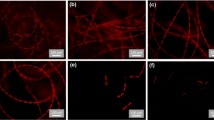Abstract
Structural materials containing silicon are produced in single celled organisms through to higher plants and animals. Hydrated amorphous silica is a colloidal mineral of infinite functionality that is formed into structures with microscopic and macroscopic form. Proteins and proteoglycans are suggested to play a critical role in the catalysis of silica polycondensation and in structure direction during the formation of these magnificent structures. This article extends knowledge on the effect of protein containing biosilica extracts from Equisetum telmateia on the kinetics of silica formation and structure regulation. Utilising potassium silicon catecholate as the source of soluble silicon, bioextracts obtained from plant silica by dissolution of the siliceous phase with aqueous HF following extensive acid digestion of the plant cell wall were found to modify the kinetic rate constants for the formation of small silicic acid oligomers under circumneutral pH conditions and to modify the solubility of silicic acid in solution. Addition of the bioextracts at ca. 1 wt% to the reaction medium reduced the sizes and range of sizes of the fundamental silica particles formed and led to the formation of crystalline polymorphs of silica under conditions of ca. neutral pH, room temperature and in the absence of multiply charged cations, conditions assumed to be relevant to the biological mineralization environment. The ability of biological organisms to regulate the formation of silica structures with prevention of crystallinity is discussed as are the implications of this study in terms of the generation of new materials with specific form and function for industrial application.











Similar content being viewed by others
References
Voronkov MG (1993) In: Corey JY, Corey ER, Gaspar PP (eds) Silicon chemistry. Ellis Horwood Ltd, Chichester, pp 145–152
Iler RK (1979) The chemistry of silica. Plenum Press, New York
Hartmann WD (1981) In: Volcani BE, Simpson TL (eds) Silicon and siliceous structures in biological systems. Springer, Berlin Heidelberg New York, pp 453–493
Garrone R, Simpson TL, Pottu-Boumendil J (1981) In: Volcani BE, Simpson TL (eds) Silicon and siliceous structures in biological systems. Springer, Berlin Heidelberg New York, pp 495–525
Sangster AG, Parry DW (1981) In: Volcani BE, Simpson TL (eds) Silicon and siliceous structures in biological systems. Springer, Berlin Heidelberg New York, pp 383–407
Mann S, Perry CC, Williams RJP, Fyfe CA, Gobbi GC, Kennedy GJ (1983) Chem Soc Chem Commun 168
Volcani BE (1978) In: Bendz G, Lindqvist I (eds) Biochemistry of silicon and related problems. Plenum Press, New York, pp 177–204
Wetherbee R, Crawford S, Mulvaney P (2000) In: Bauerlein E (ed) Biomineralization from biology to biotechnology and medical application. Wiley-VCH, pp 189–206
Perry CC, Keeling-Tucker T (2000) J Biol Inorg Chem 5:537
Frondel C (1962) The system of mineralogy of DANA, 7th edn, vol3. Wiley, New York
Vrieling EG, Beelen TPM, van Santen RA, Gieskes WWC (1999) J Biotechnol 70:39
Monje PV, Baran EJ (2000) J Plant Physiol 157:457
Perry CC (1989) In: Mann S, Webb J, Williams RJP (eds) Biomineralisation, chemical and biological perspectives. VCH, New York, pp 223–256
Mann S, Perry CC (1986) In: Evered D, O'Connor M (eds) Silicon biochemistry. CIBA Symposium 121, pp 40–58
Borowitza MA, Volcani BE (1978) J Phycol 14:10
Schmid AMM, Schulz D (1979) Protoplasma 100:267
Perry CC, Moss EJ, Williams RJP (1990) Proc R Soc London B241:47
Frohlich F (1989) Terra Nova 1:267
Sada E, Kumazawa H, Koresawa E (1990) Chem Eng J 44:133
Bogush GH, Zukoski CF (1990) J Colloid Interface Sci 142:1
Lewis DW, Willock DJ, Catlow CRA, Thomas JM, Hutchings GJ (1996) Nature 382:604
Kresge CT, Leowicz ME, Roth WJ, Vartuli JC, Beck JS (1992) Nature 359:710
Zhou Y, Shimizu K, Cha JN, Stucky GD, Morse DE (1999) Angew Chem Int Ed 38:780
Cha JN, Shimizu K, Zhou Y, Christiansen SC, Chmelka BF, Stucky GD, Morse DE (1999) Proc Natl Acad Sci USA 96:361
Kröger N, Deutzmann R, Sumper M (1999) Science 286:1129
Swift DM, Wheeler AP (1992) J Phycol 28:202
Perry CC, Keeling-Tucker T (1998) J Chem Soc Chem Commun 2587
Vrieling EG, Gieskes WWC, Beelen TPM (1999) J Phycol 35:548
Kroger N, Deutzmann R, Sumper M (2001) J Biol Chem 276:26,066
Harrison CC (1996) Phytochemistry 41:37
Cornish-Bowden A (1983) Meth Enzymol 91:60
Evans DF, Parr J, Coker EN (1990) Polyhedron 9:813
Harrison CC, Loton N (1995) J Chem Soc Faraday Trans 91:4287
Miller JC, Miller JN (1993) In: Statistics for analytical chemistry. Ellis Horwood, Chichester, UK
Perry CC, Fraser MA (1991) Phil Trans R Soc London B334:149
Rosenfeld Y, Hacohen E, Grunbaum E, Tenne R, Sloan J, Hutchison JL (1998) Nature 395:336
Marsh RE, Corey RB, Pauling L (1955) Biochim Biophys Acta 16:1
Lobel KD, West JK, Hench LL (1996) J Mater Sci Lett 15:648
Hench LL (1994) In: Cheetham AK, Brinker CJ, Mecartney ML, Sanchez C (eds) Better ceramics through chemistry VI. Materials Research Society, Pittsburgh, pp 993–1004
http://iona.cryst.bbk.ac.uk
Hartwig BA, Hench LL (1972) J Biomed Mater Res 6:413
West JK, Hench LL (1994) J Biomed Mater Res 28:625
Kroger N, Sumper M (2000) In: Bauerlein E (ed) Biomineralization from biology to biotechnology and medical application. Wiley-VCH, pp 151–170
Morse DE (1999) Trend Biotechnol 17:230
Cha JN, Stucky GD, Morse DE, Deming TJ (2000) Nature 403:289
Mizutani T, Nagase H, Fujiwara N, Ogoshi H (1998) Bull Chem Soc Jpn 71:2017
Acknowledgements
Dr Derek Walton of Derby University is thanked for tangential flow purification, Anthony Willis of the MRC Immunochemistry Unit, University of Oxford for the amino acid analyses and Professor Mark Weller of Southampton University for the extended X-ray diffraction studies. Crosfield Chemicals are thanked for financial support.
Author information
Authors and Affiliations
Corresponding author
Rights and permissions
About this article
Cite this article
Perry, C.C., Keeling-Tucker, T. Model studies of colloidal silica precipitation using biosilica extracts from Equisetum telmateia . Colloid Polym Sci 281, 652–664 (2003). https://doi.org/10.1007/s00396-002-0816-7
Received:
Accepted:
Published:
Issue Date:
DOI: https://doi.org/10.1007/s00396-002-0816-7




